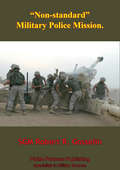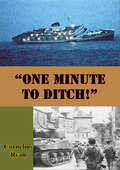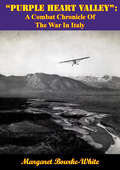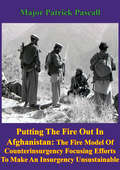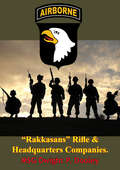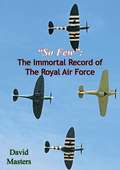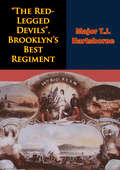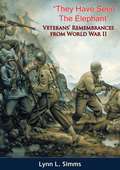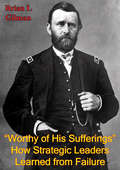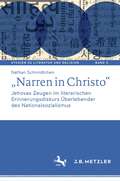- Table View
- List View
“Non-Standard” Military Police Mission (Eyewitness To Modern War #2)
by SGM Robert R. GosselinMy field artillery unit was mobilized to perform a non-standard military police mission during Operation Iraqi Freedom II. The unit was part of the largest National Guard mobilization from our state since the Vietnam era. The challenges of deploying a field artillery unit as an ad hoc MP company were many. The challenges were overcome through the strength of our NCO Corps. As I write this paper, I am preparing for a deployment, a non-standard mission with my current unit. As I compare the two mobilizations, it is apparent that the process for mobilizing, training and preparing our soldiers has improved since the first rotation, but issues concerning the selection of units for non-standard mission still exist five years later.
“One Minute to Ditch!”
by Cornelius RyanPrize-winning True Stories of the Supreme Moment--When Men Suddenly Face DeathSome of these true stories are already famous because they have been dramatized on television. All of them take you straight to the heart of great moments of crisis.You'll know what it's like to look down at the wide Pacific and realize that your plane is going to ditch there.You'll twist the wheel of your racing car as it takes a narrow turn at Indianapolis.You'll struggle in cabin 56 of the S.S. Andrèa Doria during its five last frantic hours.In these and other stories, Cornelius Ryan, ace journalist, has caught the essence of that split-second that may be a man's last. Two of these pieces have won Benjamin Franklin Magazine awards."One Minute To Ditch!"--Thirty-one men, women and children high over the mid-Pacific in a failing plane. (Dramatized on TV.)Five Desperate Hours in Cabin 56--A story of the sinking of the S.S. Andrèa Doria told in gripping minute-by-minute detail. (Dramatized on TV.)The Major of St. Lô--A classic of the Normandy invasion, an unforgettable true story of quiet heroism. (Dramatized on TV.)These and other factual accounts are moving documents of crisis: of courage against the sudden fact of very possible death.
“Purple Heart Valley”: A Combat Chronicle Of The War In Italy
by Margaret Bourke-WhiteAn excellent, richly illustrated, account of the bloodiest phase of the Italian campaign.Here is a report--in pictures and in words--of exactly what happened to our men during the bitterest phases of the Italian campaign. This report is not based upon a hurried visit behind the lines; Margaret Bourke-White spent a full five months on the Italian front photographing, questioning, observing, and living in close association with our troops. She was not content to remain safely behind the combat area. She flew over the German lines and narrowly escaped being shot down. On the ground she came closer to the enemy lines than any woman has been before the most advanced American post around Cassino.
“Putting Out The Fire In Afghanistan”: - The Fire Model of Counterinsurgency: Focusing Efforts to Make an Insurgency Unsustainable
by Major Patrick PascallThis monograph develops an alternative approach to counterinsurgency, and explains how the current narratives in the field of counterinsurgency are not completely accurate. Counterinsurgents only need to properly understand the environment and then concentrate their efforts in that critical area of the insurgency identified as the sustainer of that insurgency. The U.S. counterinsurgency (COIN) plan does not need to address all those lines of effort not directly related to the root cause of an insurgency, as those efforts may actually fuel the insurgency due to building unrealistic expectations among the populace.This monograph also develops the analogy that the four elements necessary for a fire (fuel, oxygen, heat, chain reaction) parallel the necessary elements of an insurgency (the fuel representing unresponsive government, oxygen representing existing structures/vulnerability, heat representing political/diplomatic factors, chain reaction representing the information environment, and the population). Like a fire, if one has a proper understanding of the environment, and can clearly identify the true sustainer of the insurgency (the root problem), then one only need to remove that one element from the equation, and that insurgency will be unsustainable.Having a simple approach will not only allow the counterinsurgents to better utilize their resources-in an Economy of Force-and allow them to Mass their power on one clear Objective, it will also remind counterinsurgents of the other Principle of War that has proven to be so critical in complex environments-simplicity.
“Rakkasans” Rifle & Headquarters Companies (Eyewitness To Modern War #3)
by MSG Dwight P. DooleySenior NCO MSG Dwight P. Dooley recounts his experiences of the War in Iraq when stationed there as part of the 101st "Screaming Eagles Airborne Division between 09/20/2005 - 05/18/2006.This paper explains the different experiences and the similarities I experienced as First Sergeant in Crusher & Hatchet Company, 1-187TH Infantry Regiment. Both companies presented completely different experiences but they were equally satisfying. My rifle company was a company known for its rough around the edges attitude and for its ability to eliminate any opposing threat. My headquarters company was known for its ability to figure things out and apply a logical and methodical approach to everything. These two companies were completely different in nature, but equal in their abilities to accomplish any given task.
“So Few”: The Immortal Record of The Royal Air Force
by David MastersOriginally published in 1941, this book is author David Masters' historical account of the Royal Air Force's feats and accomplishments during the Second World War: "I count it a privilege to write with firsthand knowledge of these flying crusaders who are fighting a holy war to preserve Christendom and the lives and liberties of earth-bound mortals. They are the flower of Great Britain and the British Empire, selected in the most scientific manner for the posts of honour which they have covered with so much glory. None but the best will do, and those who achieve their desire of becoming pilots and navigators and gunners and wireless operators in the Royal Air Force are in fact the finest specimens of young manhood who walk the earth, young men whose physical fitness, nervous control, mental alertness and swift muscular reactions make them fit to command and man the giant bombers and handle the darting fighters; they are the knights of the air whose prowess and sacrifice will conjure a new and nobler order out of the ruins created by Hitler and Mussolini. No trouble has been spared to ensure the accuracy of these pages which reflect the glory of the Royal Air Force. It may be taken that they are as authentic as any pages of official history."
“The Red-Legged Devils”, Brooklyn’s Best Regiment
by Major T.J. HartshorneThe Fourteenth Regiment New York State Militia of Brooklyn, New York gathered an impressive combat record during the Civil War, yet the Professional Military Education world rarely takes notice of their deeds. They were first formed on 5 July 1847 when the New York State Legislature consolidated the individual militia companies into regiments. During the Civil War the Fourteenth Regiment fought in 29 engagements and sustained over 700 casualties. Their battles include participation in both Bull Runs, Antietam, Fredericksburg, Chancellorsville, Gettysburg, Wilderness and Spotsylvania. Though noted primarily for actions in the Civil War, the Regiment also served in the Spanish American War, World Wars I and II, and Korea, though under different unit designations. The Fourteenth Regiment's past can be a road to our future. An insight to their performance under fire can provide today's students a timeless template on how to conduct combat operations.
“They Have Seen The Elephant”: Veterans’ Remembrances from World War II
by Lynn L. SimmsThese stories happened over 40 years ago, all over the world, and they are set down here so they can remind us of other times and places where Americans fought for their country. No single soldier "won the war," rather each was trained, went where he was told and did his job when needed.War became a way of life, an opportunity for undreamed-of travel, a time in which many grew up, some received equal treatment for the first time, some enjoyed working as part of a team, some felt proud, but for all it was an experience few would have wanted to miss, but none would want to repeat.
“Worthy Of His Sufferings”: How Strategic Leaders Learned From Failure
by Brian J. GilmanHistory provides numerous examples of leaders who failed at some point in their career, yet went on to become great leaders. Their example demonstrates that experiencing failure does not necessarily equate to failed leadership-leaders can and do recover from failure to become better leaders. But how does this occur? How does a leader turn the psychological trauma of failure into an important learning experience that leads to personal growth? What leadership characteristics and actions are most important in recovering from a leadership failure? This paper examines these questions along several major themes: first, the psychological trauma of failure and the pathways to post-traumatic growth following failure; second, a study of how contemporary leaders grew from failure; and third, historical case studies on two strategic leaders who grew from the experience of failure: Ulysses S. Grant and Dwight D Eisenhower. In conclusion, the paper compares the lessons from these historical case studies to those drawn from the first two themes to identify the key leadership characteristics and actions that enable leaders to recover from failure.
„Narren in Christo“: Jehovas Zeugen im literarischen Erinnerungsdiskurs Überlebender des Nationalsozialismus (Studien zu Literatur und Religion / Studies on Literature and Religion #5)
by Nathan SchmidtchenDie vorliegende Studie ist die erste, die den Erinnerungsspuren nachgeht, die Jehovas Zeugen (Bibelforscher) in den Erzähltexten Überlebender des Nationalsozialismus hinterlassen haben. Trotz unterschiedlicher Erinnerungskulturen und -interessen seitens der Autoren ergibt sich ein einheitliches und zugleich schillerndes Bild. Häufig nur Erzählobjekte ohne eigene Stimme, bleiben sie randständig, andersartig und widersprüchlich. Jehovas Zeugen faszinieren, befremden und stören. Als Heilige, Propheten, Märtyrer, Samariter und Sündenböcke stehen sie in der Nachfolge des Sohnes Gottes. Bezüge ergeben sich auch zur Figur des christlichen Narren: nicht von dieser Welt, der Welt des nationalsozialistischen Terrors, aber zugleich in ihr und gegen sie zeugend.
